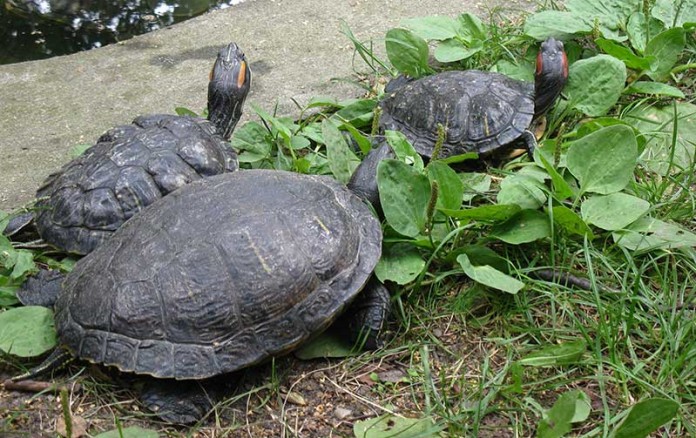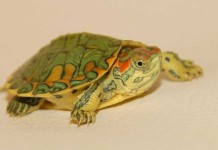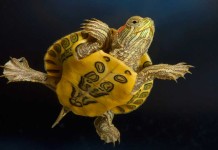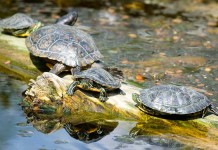Red-eared slider breeding is a lot tougher than you may think. You can’t just put a male and female together and wait for the hatchlings to show up. To make sure that your sliders breed, you need to mimic their natural conditions and life cycle as closely as possible. In the wild, red eared sliders generally breed after two weeks of hibernation in the spring so that their babies hatch out when the weather is good and warm. To prepare your turtle for hibernation, begin reducing the photoperiod on its lights slowly over a period of time and fast the turtle for 10 days. During the last 3 days of the fast, soak your slider to make sure it completely empties out its digestive tract. Next, place the slider in a hibernaculum, a tank with one inch of potting soil and some loose hay sphagnum, soil and moss. Drop the temperature within slowly until it reaches 50-55 degrees Fahrenheit. After the hibernation period, slowly raise the temperature over 1-2 days until it reaches 85 degrees, then return your turtles to their regular tank. Once they seem ready to eat, make sure you give them lots of food so they can increase their energy.
At this time, you can place your turtles together. The male will do his mating dance and she will either be receptive or they will fight. You will know they are breeding when the male has mounted the female and their tails are entwined. Give them about 45 minutes and if they don’t breed, separate them. You can try red-eared slider breeding again in two days.
Once red-eared slider breeding has occurred, give your female a 20-gallon gestation tank with 4 inches of loose potting soil (such as vermiculite) for her to lay her eggs in. Make sure you keep her warm (80-86 degrees Fahrenheit), damp, and disturb her as little as possible. She may not eat during this time, but do not be alarmed, as this is perfectly normal. As long as the situation is ideal, she’ll lay her eggs in two months and it will take another 80-85 days for the hatchlings to hatch.
A few months after red-eared slider breeding, you’ll have your hatchlings. Once your hatchlings have arrived, don’t disturb them for about a day. They will not leave their shell if they don’t feel safe, so just observe them quietly. Once they have all dug out of the soil, put them in their own tank, which should be about 20 gallons per 12 hatchlings. Make sure it has a full spectrum light that mimics the sun’s rays (available at any pet store) and proper heating (80-86 degrees Fahrenheit). For their food, make sure you chop the appropriate food (mealworms, earthworms, or pellets) into small enough chunks that it fits into your hatchlings’ mouths and they won’t choke. If they won’t eat, try offering them some ham or lean beef. If that doesn’t work, you can force feed them with an eye dropper full of beef blood and turtle vitamins. Don’t overdo it; you just want to get their appetite going so they can eat on their own. Red-eared slider breeding can be more difficult if you decide to incubate the eggs on your own, but this is not recommended unless you are properly prepared.










